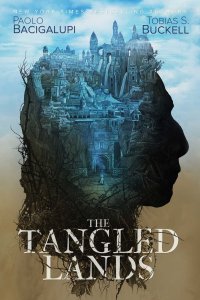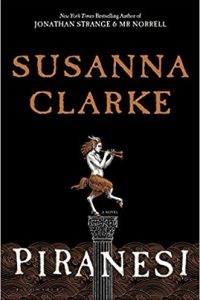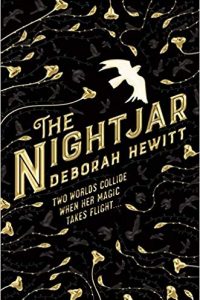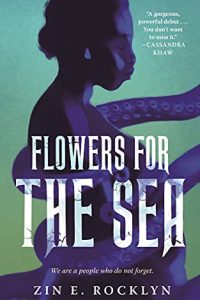Gary K. Wolfe Reviews The Tangled Lands by Paolo Bacigalupi & Tobias S. Buckell
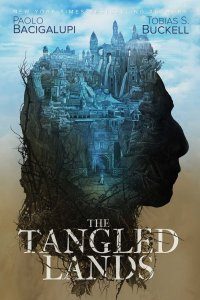 The Tangled Lands, Paolo Bacigalupi & Tobias S. Buckell (Saga 978-1481497299, $26.99, 304pp, hc) February 2018.
The Tangled Lands, Paolo Bacigalupi & Tobias S. Buckell (Saga 978-1481497299, $26.99, 304pp, hc) February 2018.
Nearly eight years ago, Tobias S. Buckell & Paolo Bacigalupi joined forces to create a high-fantasy world with a lot of familiar late-medieval/early Renaissance trappings and one particularly neat device: every act of magic or spellcasting, no matter how small, fuels the rapid growth of dense, poisonous brambles already threatening to encroach the land. Each wrote a novella set in this world, Bacigalupi’s The Alchemist and Buckell’s The Executioness, published as an audiobook by Audible and later in separate volumes from Subterranean Press (reviewed here in December 2010). Now they’ve returned to this world with two additional novellas, Bacigalupi’s “The Children of Khaim” and Buckell’s “The Blacksmith’s Daughter”, all four packaged as The Tangled Lands. It’s a bit of a chimera, a suite of standalone stories with different themes, a common setting, and a few recurring characters, mostly the bad guys. As a sampler of what this world might yield, it’s fascinating, but anyone expecting a shape resembling a novel, or even a clear narrative arc, might come away disappointed.
The arrangement of the four stories does at least suggest a chronology. The lead story, Bacigalupi’s “The Alchemist”, has much of the feel of a SF tale, focusing on Jeoz, an alchemist whose approach to the bramble problem mostly involves non-magical scientific strategies – observation (the bramble doesn’t grow around copper mines), invention (a musket-like “balanthast” with a combustion chamber), and experimentation (seeking the right mix of ingredients in the combustion chamber to affect the bramble). But Jeoz doesn’t abjure magic entirely, using it to keep his seriously ill daughter alive (the most heartbreaking scene is Bacigalupi’s opening, when Jeoz is forced to sell his last piece of furniture, his young daughter’s bed, in order to put food on the table – but we come to understand that paying for his research is partly what has brought him to such dire straits). The balanthast, which turns out to be the most effective instrument yet in fighting the bramble, becomes a kind of MacGuffin for the entire series, but it’s also what eventually gets the alchemist in trouble when he presents his bramble-busting device to the powerful Mayor of the city of Khaim, whose own personal magus, Scaczi – the only one whose magic is legal – sees the new invention as a threat to his own power. The tale ends as a fable of scientific research co-opted for political and military purposes, as Scaczi discovers that balanthast technology can also be used to detect magic – the smoke generated causes anyone or anything recently affected by magic to glow a brilliant blue. Instead of solving the bramble problem, the new invention is used to further suppress the use of magic, cementing the mayor’s and Scaczi’s power. But the novella’s other, broader theme – that everyday technologies we’ve become accustomed to can create lasting harm to the environment – is fully in keeping with Bacigalupi’s other work.
Neither this story nor Buckell’s “The Executioness” seem to have been revised much for this edition, although some details of Buckell’s story have been altered to account for the telltale blue glow and the growing power of Scaczi. Buckell’s story, though, in keeping with his other fiction, focuses on how the dispossessed might organize to gain power. Tana is the mother of two sons and the daughter of the town executioner. In order to keep the family afloat, she unwillingly takes on her father’s job as he lies ill. Returning from her first almost-botched execution, she finds that raiders have destroyed her home as well as the neighboring farms and villages. Her sons are missing, and her father burnt so badly that he persuades her to put him out of his misery. Searching for her sons, she tracks down the raiders and their prisoners, quixotically attacking them with her executioner’s blade and quickly getting herself nearly killed. By the time she is rescued by a passing caravan, though, word has already begun to spread about her courageous attack, and this gradually turns into a legend, which she begins to feel she must fulfill in order to find her missing sons. She thus becomes the figurehead of a growing resistance movement.
The third story, Bacigalupi’s “The Children of Khaim”, the only one not in first-person narration, introduces a new villain, the cruel and sadistic Duke Malabaz. The central figures are Mop and his young sister Rain, who are working for Malabaz to help clear bramble all the way to a nearby village, using the old-fashioned method of burning it back. It’s brutal, exhausting, and low-paying work (the balanthast is presumably still a secret technology hoarded by the Jolly Mayor and Scaczi), and a dramatic contrast to the life they once led in the beautiful city of Alacan, now lost to the brambles. One of the main hazards of such work is getting infected by the bramble itself, which produces seed pods and tendrils that can work their way into the bloodstream, resulting in a coma-like paralysis that can last for years. When the inexperienced Rain is so infected, Mop is persuaded to leave her behind, refusing to give her the “mercy cut” that will end her suffering, and prevent her possible fate as a living “doll” – a sex toy for “soft-eyed men.” Mop’s efforts to track down his sister lead him to Khaim, now known as the Blue City, and eventually to a confrontation with the evil Duke himself.
Duke Malabaz figures even more prominently in the final story, Buckell’s “The Blacksmith’s Daughter”, the most violent and action-packed story in the collection. It’s narrated by the title character Sofija, whose parents have been commissioned by the Duke to build a suit of ornamental armor for his son – but with an impossible deadline and insufficient funds to buy needed materials (at one point the Duke suggests to Sofija’s father that he sell her to get the money). They try to escape, but are captured and taken before the Majister Scaczi – whose power intimidates even the Duke, it seems. This leaves Sofija with the prospect of mounting a desperate scheme to save her parents. All four stories deal with the challenges of poverty and subsistence in a feudalistic society, and all offer glimpses of a much broader canvas – the lost empire of Jhandpara, with its floating palaces, the bramble-destroyed city of Alacan, the coastal city of Paika and its dreaded raiders, the six-armed god Borzai, etc. – but none offer much in the way of resolution. The balanthast, presented as a potentially revolutionary technology in the first story, never shows up again at all, and while a few characters seem to escape or gain reprieves, the oppressive power structure of Khaim, with its evil sorcerer Scaczi, remains intact. While each story works on its own individual terms, the collective effect is that of a series of intriguing trailers for a tantalizing epic film which we may or may not ever see in its entirety. I hope we will.
Gary K. Wolfe is Emeritus Professor of Humanities at Roosevelt University and a reviewer for Locus magazine since 1991. His reviews have been collected in Soundings (BSFA Award 2006; Hugo nominee), Bearings (Hugo nominee 2011), and Sightings (2011), and his Evaporating Genres: Essays on Fantastic Literature (Wesleyan) received the Locus Award in 2012. Earlier books include The Known and the Unknown: The Iconography of Science Fiction (Eaton Award, 1981), Harlan Ellison: The Edge of Forever (with Ellen Weil, 2002), and David Lindsay (1982). For the Library of America, he edited American Science Fiction: Nine Classic Novels of the 1950s in 2012, with a similar set for the 1960s forthcoming. He has received the Pilgrim Award from the Science Fiction Research Association, the Distinguished Scholarship Award from the International Association for the Fantastic in the Arts, and a Special World Fantasy Award for criticism. His 24-lecture series How Great Science Fiction Works appeared from The Great Courses in 2016. He has received six Hugo nominations, two for his reviews collections and four for The Coode Street Podcast, which he has co-hosted with Jonathan Strahan for more than 300 episodes. He lives in Chicago.
This review and more like it in the April 2018 issue of Locus.
 While you are here, please take a moment to support Locus with a one-time or recurring donation. We rely on reader donations to keep the magazine and site going, and would like to keep the site paywall free, but WE NEED YOUR FINANCIAL SUPPORT to continue quality coverage of the science fiction and fantasy field.
While you are here, please take a moment to support Locus with a one-time or recurring donation. We rely on reader donations to keep the magazine and site going, and would like to keep the site paywall free, but WE NEED YOUR FINANCIAL SUPPORT to continue quality coverage of the science fiction and fantasy field.


